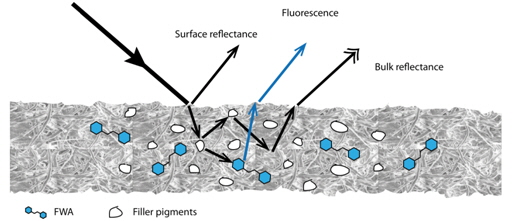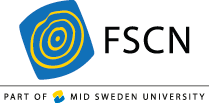Spectral characterization

Projektet finansieras av Kempestiftelsen. Information om projektet finns på engelska.
The appearance of an object, or the functionality of an optical component, depends to a large extent of how it reflects light, and especially the reflected lights spectral and angular distribution. The aim of this project is to develop more comprehensive characterization methods in terms of improved light scattering models and measurement systems.
For translucent materials, such as paper and biological tissue, a large part of the reflected light consists of bulk reflectance, i.e. light scattered within the material and eventually reflected back through the front surface. Several models exists for describing light reflected directly at the front surface, whereas successfully describing the bulk reflectance is significantly more challenging.
The different origins of light reflected or fluoresced from a paper sample. The bulk reflectance consists of light scattered from fibres, filler pigments and voids. The fluorescence is caused by light interacting with fluorescent whitening agents (FWA).
This project is therefore focused on continued development of models for bulk scattering, based on radiative transfer theory. The main objective is to develop methods for determining the materials optical parameters, in terms of scattering coefficient, absorption coefficient and asymmetry parameter, from goniophotometric measurements. The angular distribution of fluorescence is also investigated, since many materials such as paper and fabric often contain fluorescent whitening agents.
Furthermore, a modular spectral imaging system is developed for obtaining angularly, spectrally and spatially resolved reflectance and transmittance measurements. This will enable studies of the lateral distribution of inhomogeneities and artifacts at a larger scale, and provides us with new methods for optical characterization of materials and surfaces.

